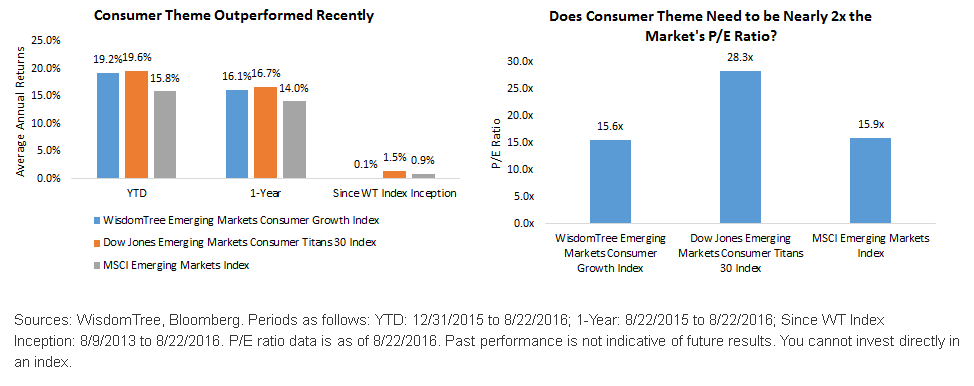Three Common Pitfalls for Targeting Emerging Market Consumers


 • Over the periods shown, the WisdomTree Emerging Markets Consumer Growth Index performed similarly to the Dow Jones Emerging Markets Consumer Titans 30 Index. Both Indexes also outperformed the MSCI Emerging Markets Index over the YTD and 1-year periods.
• What we find more remarkable, however, is that the WisdomTree Index delivered this performance and retained a P/E ratio very similar to broader emerging markets. The Dow Jones index, on the other hand, had a P/E ratio almost twice that of broader emerging markets. Remember, a high valuation today makes for a higher hurdle for future returns.
As investors become more open to emerging market allocations, we think the future of the global economy is undoubtedly powered by the emerging market consumer, and WisdomTree has developed a solution to address the common pitfalls of accessing this emerging market consumer theme.
1Source:“Future of Asia by the Numbers: 100 Facts,” compiled by Gurcharan Gill & Emily Kim, 8/16.
• Over the periods shown, the WisdomTree Emerging Markets Consumer Growth Index performed similarly to the Dow Jones Emerging Markets Consumer Titans 30 Index. Both Indexes also outperformed the MSCI Emerging Markets Index over the YTD and 1-year periods.
• What we find more remarkable, however, is that the WisdomTree Index delivered this performance and retained a P/E ratio very similar to broader emerging markets. The Dow Jones index, on the other hand, had a P/E ratio almost twice that of broader emerging markets. Remember, a high valuation today makes for a higher hurdle for future returns.
As investors become more open to emerging market allocations, we think the future of the global economy is undoubtedly powered by the emerging market consumer, and WisdomTree has developed a solution to address the common pitfalls of accessing this emerging market consumer theme.
1Source:“Future of Asia by the Numbers: 100 Facts,” compiled by Gurcharan Gill & Emily Kim, 8/16.
Important Risks Related to this Article
Investments in emerging, offshore or frontier markets are generally less liquid and less efficient than investments in developed markets and are subject to additional risks, such as risks of adverse governmental regulation and intervention or political developments.

Christopher Gannatti began at WisdomTree as a Research Analyst in December 2010, working directly with Jeremy Schwartz, CFA®, Director of Research. In January of 2014, he was promoted to Associate Director of Research where he was responsible to lead different groups of analysts and strategists within the broader Research team at WisdomTree. In February of 2018, Christopher was promoted to Head of Research, Europe, where he was based out of WisdomTree’s London office and was responsible for the full WisdomTree research effort within the European market, as well as supporting the UCITs platform globally. In November 2021, Christopher was promoted to Global Head of Research, now responsible for numerous communications on investment strategy globally, particularly in the thematic equity space. Christopher came to WisdomTree from Lord Abbett, where he worked for four and a half years as a Regional Consultant. He received his MBA in Quantitative Finance, Accounting, and Economics from NYU’s Stern School of Business in 2010, and he received his bachelor’s degree from Colgate University in Economics in 2006. Christopher is a holder of the Chartered Financial Analyst Designation.

